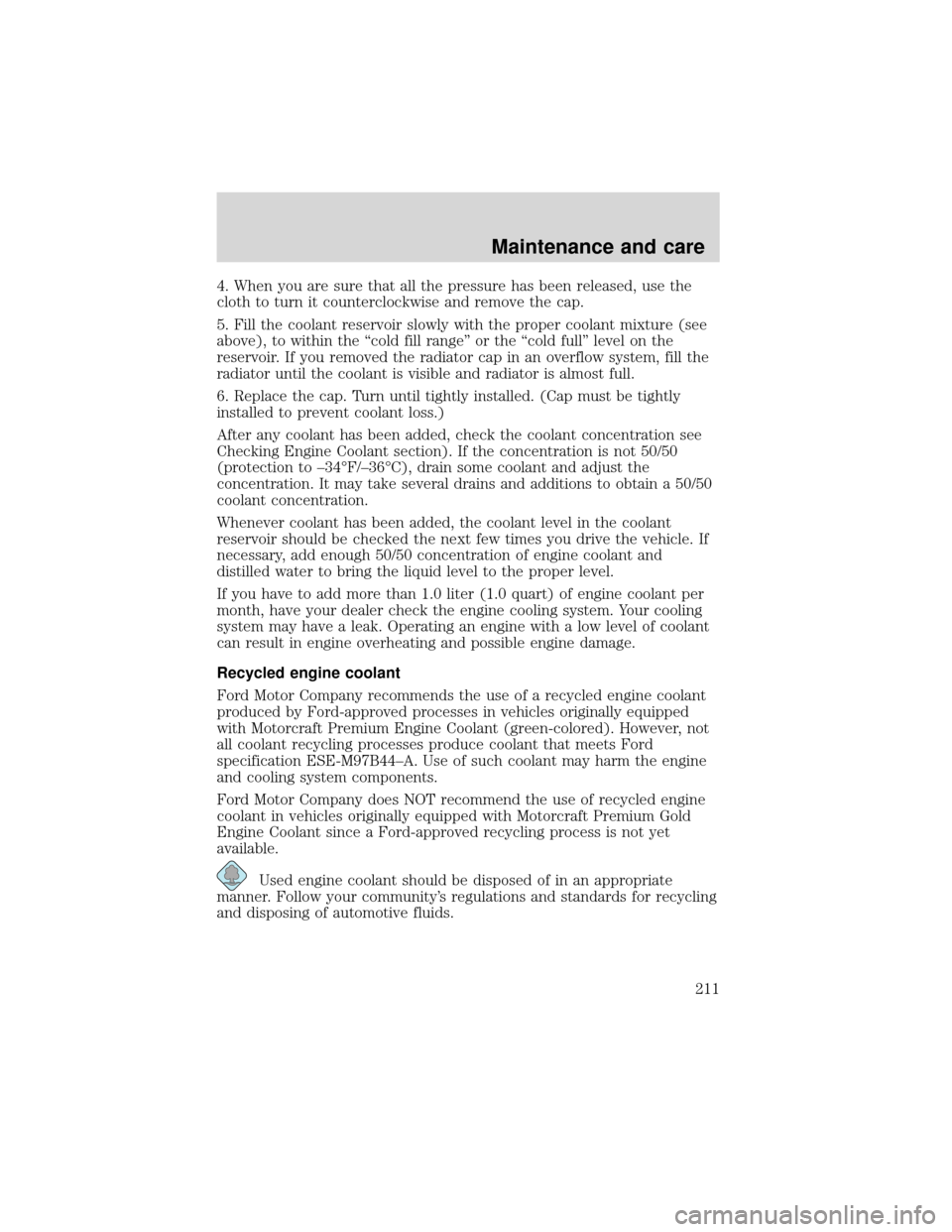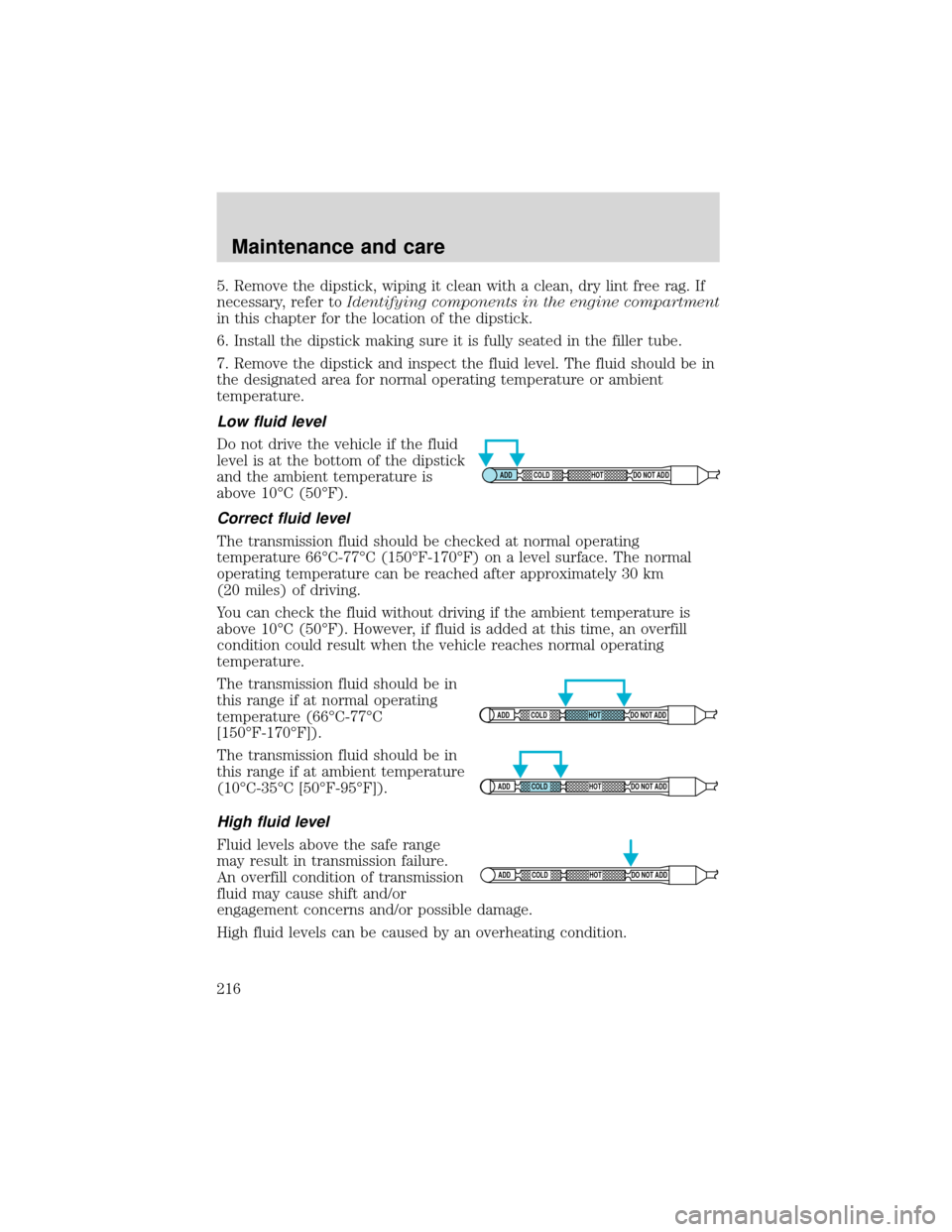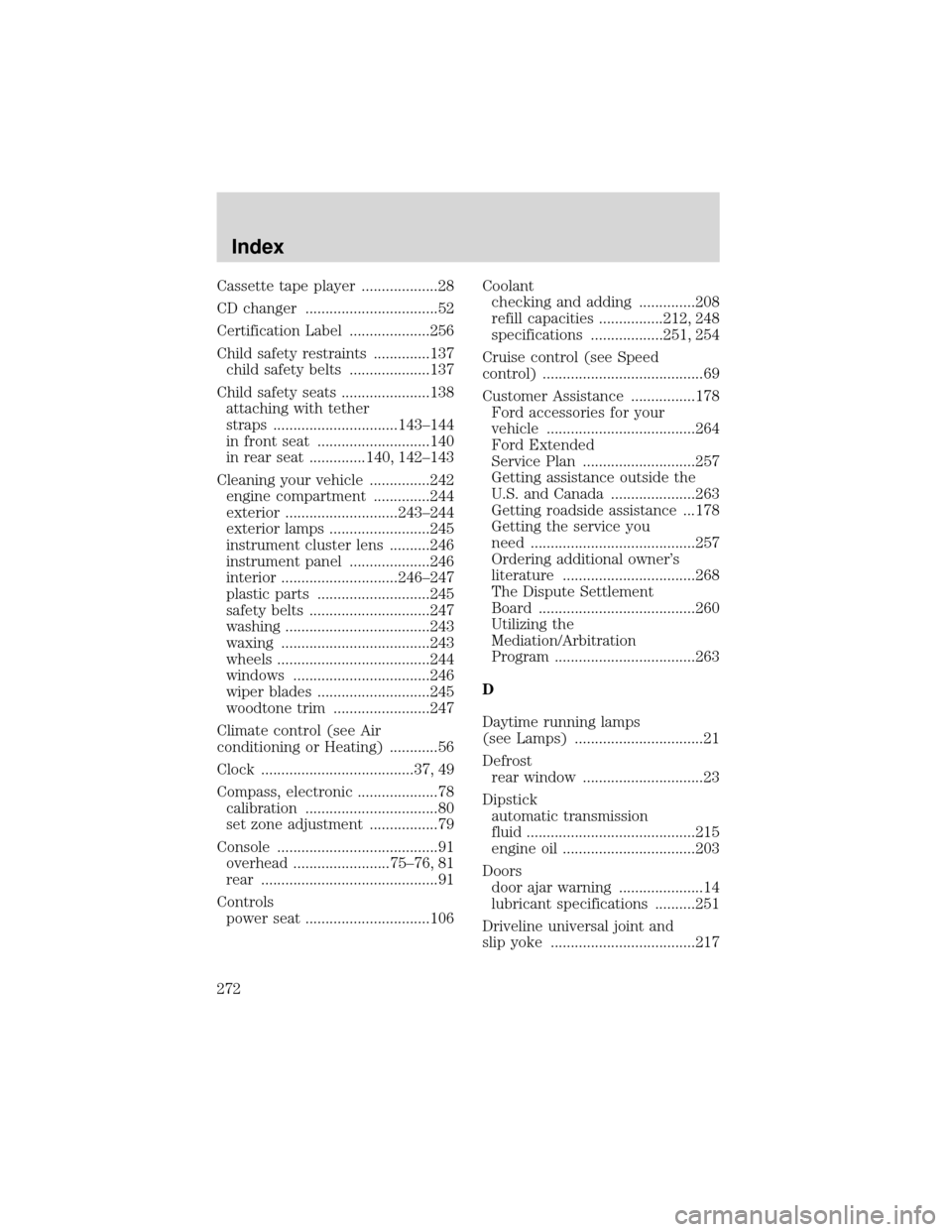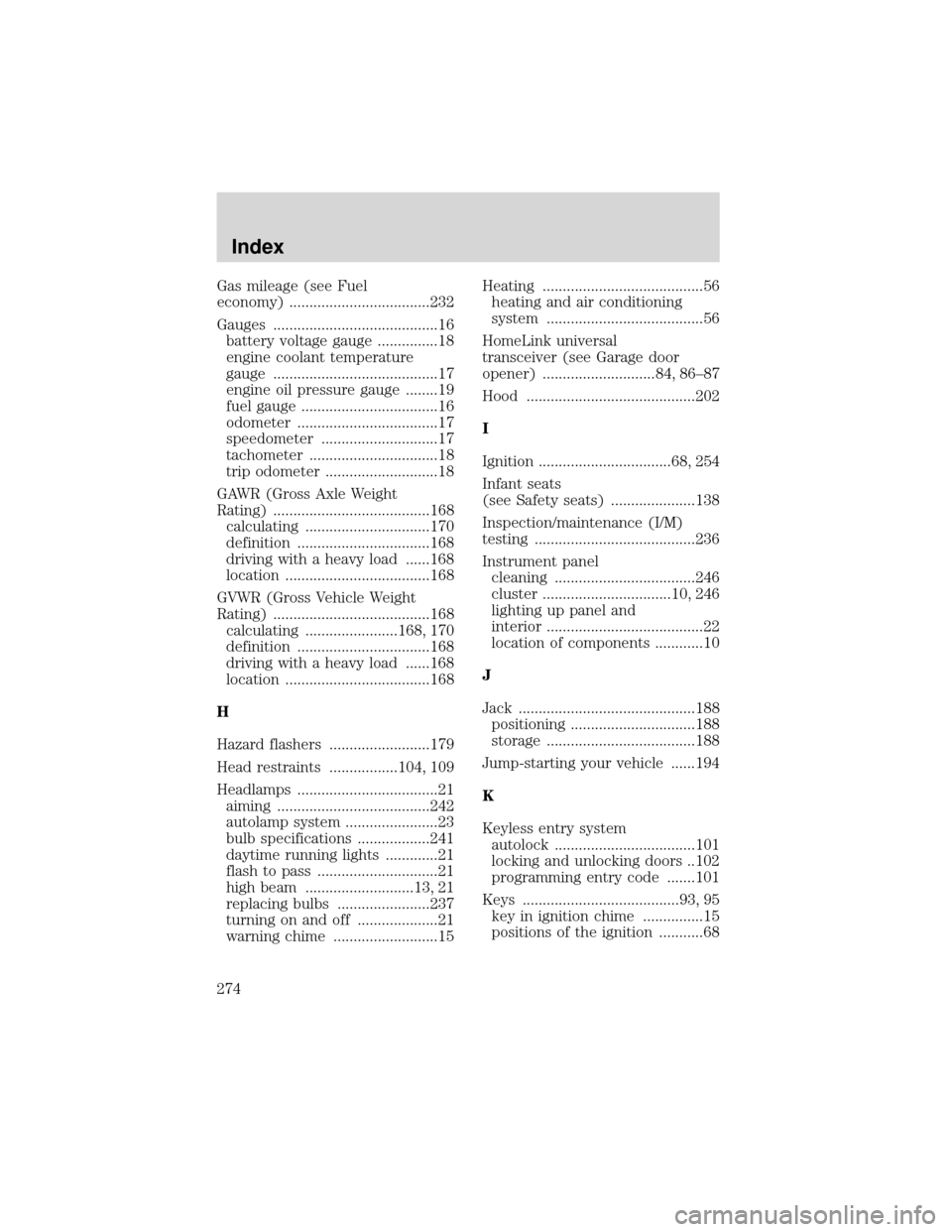2001 FORD EXPEDITION heating
[x] Cancel search: heatingPage 211 of 280

4. When you are sure that all the pressure has been released, use the
cloth to turn it counterclockwise and remove the cap.
5. Fill the coolant reservoir slowly with the proper coolant mixture (see
above), to within the“cold fill range”or the“cold full”level on the
reservoir. If you removed the radiator cap in an overflow system, fill the
radiator until the coolant is visible and radiator is almost full.
6. Replace the cap. Turn until tightly installed. (Cap must be tightly
installed to prevent coolant loss.)
After any coolant has been added, check the coolant concentration see
Checking Engine Coolant section). If the concentration is not 50/50
(protection to–34°F/–36°C), drain some coolant and adjust the
concentration. It may take several drains and additions to obtain a 50/50
coolant concentration.
Whenever coolant has been added, the coolant level in the coolant
reservoir should be checked the next few times you drive the vehicle. If
necessary, add enough 50/50 concentration of engine coolant and
distilled water to bring the liquid level to the proper level.
If you have to add more than 1.0 liter (1.0 quart) of engine coolant per
month, have your dealer check the engine cooling system. Your cooling
system may have a leak. Operating an engine with a low level of coolant
can result in engine overheating and possible engine damage.
Recycled engine coolant
Ford Motor Company recommends the use of a recycled engine coolant
produced by Ford-approved processes in vehicles originally equipped
with Motorcraft Premium Engine Coolant (green-colored). However, not
all coolant recycling processes produce coolant that meets Ford
specification ESE-M97B44–A. Use of such coolant may harm the engine
and cooling system components.
Ford Motor Company does NOT recommend the use of recycled engine
coolant in vehicles originally equipped with Motorcraft Premium Gold
Engine Coolant since a Ford-approved recycling process is not yet
available.
Used engine coolant should be disposed of in an appropriate
manner. Follow your community’s regulations and standards for recycling
and disposing of automotive fluids.
Maintenance and care
211
Page 216 of 280

5. Remove the dipstick, wiping it clean with a clean, dry lint free rag. If
necessary, refer toIdentifying components in the engine compartment
in this chapter for the location of the dipstick.
6. Install the dipstick making sure it is fully seated in the filler tube.
7. Remove the dipstick and inspect the fluid level. The fluid should be in
the designated area for normal operating temperature or ambient
temperature.
Low fluid level
Do not drive the vehicle if the fluid
level is at the bottom of the dipstick
and the ambient temperature is
above 10°C (50°F).
Correct fluid level
The transmission fluid should be checked at normal operating
temperature 66°C-77°C (150°F-170°F) on a level surface. The normal
operating temperature can be reached after approximately 30 km
(20 miles) of driving.
You can check the fluid without driving if the ambient temperature is
above 10°C (50°F). However, if fluid is added at this time, an overfill
condition could result when the vehicle reaches normal operating
temperature.
The transmission fluid should be in
this range if at normal operating
temperature (66°C-77°C
[150°F-170°F]).
The transmission fluid should be in
this range if at ambient temperature
(10°C-35°C [50°F-95°F]).
High fluid level
Fluid levels above the safe range
may result in transmission failure.
An overfill condition of transmission
fluid may cause shift and/or
engagement concerns and/or possible damage.
High fluid levels can be caused by an overheating condition.
ADD COLD HOT DO NOT ADD
ADD COLD HOT DO NOT ADD
ADD COLD HOT DO NOT ADD
ADD COLD HOT DO NOT ADD
Maintenance and care
216
Page 272 of 280

Cassette tape player ...................28
CD changer .................................52
Certification Label ....................256
Child safety restraints ..............137
child safety belts ....................137
Child safety seats ......................138
attaching with tether
straps ...............................143–144
in front seat ............................140
in rear seat ..............140, 142–143
Cleaning your vehicle ...............242
engine compartment ..............244
exterior ............................243–244
exterior lamps .........................245
instrument cluster lens ..........246
instrument panel ....................246
interior .............................246–247
plastic parts ............................245
safety belts ..............................247
washing ....................................243
waxing .....................................243
wheels ......................................244
windows ..................................246
wiper blades ............................245
woodtone trim ........................247
Climate control (see Air
conditioning or Heating) ............56
Clock ......................................37, 49
Compass, electronic ....................78
calibration .................................80
set zone adjustment .................79
Console ........................................91
overhead ........................75–76, 81
rear ............................................91
Controls
power seat ...............................106Coolant
checking and adding ..............208
refill capacities ................212, 248
specifications ..................251, 254
Cruise control (see Speed
control) ........................................69
Customer Assistance ................178
Ford accessories for your
vehicle .....................................264
Ford Extended
Service Plan ............................257
Getting assistance outside the
U.S. and Canada .....................263
Getting roadside assistance ...178
Getting the service you
need .........................................257
Ordering additional owner’s
literature .................................268
The Dispute Settlement
Board .......................................260
Utilizing the
Mediation/Arbitration
Program ...................................263
D
Daytime running lamps
(see Lamps) ................................21
Defrost
rear window ..............................23
Dipstick
automatic transmission
fluid ..........................................215
engine oil .................................203
Doors
door ajar warning .....................14
lubricant specifications ..........251
Driveline universal joint and
slip yoke ....................................217
Index
272
Page 274 of 280

Gas mileage (see Fuel
economy) ...................................232
Gauges .........................................16
battery voltage gauge ...............18
engine coolant temperature
gauge .........................................17
engine oil pressure gauge ........19
fuel gauge ..................................16
odometer ...................................17
speedometer .............................17
tachometer ................................18
trip odometer ............................18
GAWR (Gross Axle Weight
Rating) .......................................168
calculating ...............................170
definition .................................168
driving with a heavy load ......168
location ....................................168
GVWR (Gross Vehicle Weight
Rating) .......................................168
calculating .......................168, 170
definition .................................168
driving with a heavy load ......168
location ....................................168
H
Hazard flashers .........................179
Head restraints .................104, 109
Headlamps ...................................21
aiming ......................................242
autolamp system .......................23
bulb specifications ..................241
daytime running lights .............21
flash to pass ..............................21
high beam ...........................13, 21
replacing bulbs .......................237
turning on and off ....................21
warning chime ..........................15Heating ........................................56
heating and air conditioning
system .......................................56
HomeLink universal
transceiver (see Garage door
opener) ............................84, 86–87
Hood ..........................................202
I
Ignition .................................68, 254
Infant seats
(see Safety seats) .....................138
Inspection/maintenance (I/M)
testing ........................................236
Instrument panel
cleaning ...................................246
cluster ................................10, 246
lighting up panel and
interior .......................................22
location of components ............10
J
Jack ............................................188
positioning ...............................188
storage .....................................188
Jump-starting your vehicle ......194
K
Keyless entry system
autolock ...................................101
locking and unlocking doors ..102
programming entry code .......101
Keys .......................................93, 95
key in ignition chime ...............15
positions of the ignition ...........68
Index
274